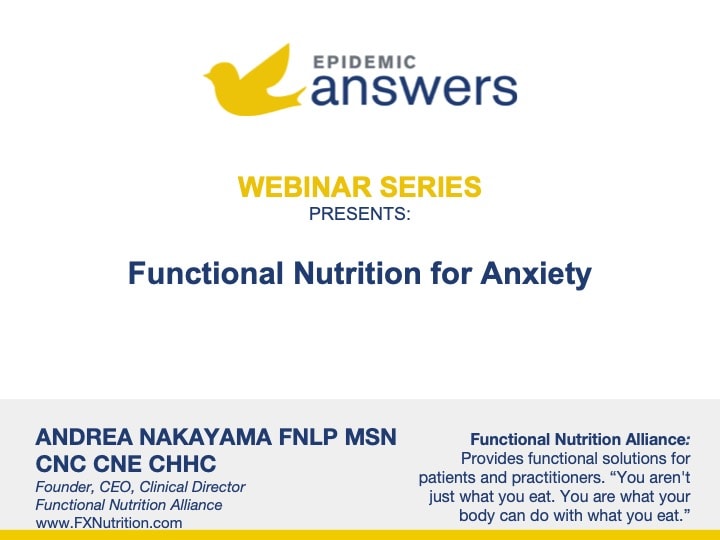We interviewed Trudy Scott, author of The Antianxiety Food Solution and the host of The Anxiety Summit, about GABA and glutamate and what works for anxiety. Please note that you will be asked to provide your email address at the 30-minute mark to continue viewing the replay.
GABA and Glutamate
GABA and glutamate are neurotransmitters and amino acids that can affect the body’s ability to deal with stress and anxiety. GABA is a calming neurotransmitter, while glutamate is excitatory.
Both are needed for optimal function of the brain, but in this day and age, it is easy to have an excess of glutamate due to:
- Stress
- Infections that cross the blood-brain barrier (PANS/PANDAS)
- Pyroluria, a condition in which vitamin B6 and zinc are overly excreted
- An excess of free glutamates in the diet
- Toxic heavy metals such as:
- Aluminum
- Mercury
- Lead
- Tin
- Fipronil, glyphosate and other pesticides
- Fluoride
- Phthalates
- Electromagnetic frequencies (EMFs)
- Low blood sugar
- Brain inflammation stemming from any of the above factors or other factors
An excess of glutamate can contribute to symptoms of:
- Seizures
- Anxiety and other mood disorders
- Autism
- ADHD
- Sensory Processing Disorder
- PANS/PANDAS
- Other neurological disorders
Because of this potential for excess glutamate to be harmful, it’s important to understand how to balance GABA and glutamate.
In This Webinar
Here’s what we discussed in this webinar:
- The connection between toxins and anxiety
- Problems with too little GABA and too much glutamate
- The basics in case someone doesn’t know anything about GABA
- How a particular insecticide called fipronil disrupts the GABA glutamate balance and where it is found
- Solutions and alternatives
- The toxic effects of fluoride and how might GABA help
- Surprising sources of fluoride
- The effect of phthalates on anxiety, where are they found, and how GABA helps
- The importance of neurotransmitter support and where you can get it
You can find Trudy’s Amino Acid Questionnaire here and her blog about GABA Calm here; we discussed both of these during the webinar, so listen in!
About Trudy Scott CN
 Food Mood Expert Trudy Scott, a certified nutritionist, educates anxious individuals about nutritional solutions for anxiety. She is known for her expertise in the use of targeted individual amino acids, which offer hope and immediate relief from anxiety so other underlying root causes and dietary changes can be addressed with ease.
Food Mood Expert Trudy Scott, a certified nutritionist, educates anxious individuals about nutritional solutions for anxiety. She is known for her expertise in the use of targeted individual amino acids, which offer hope and immediate relief from anxiety so other underlying root causes and dietary changes can be addressed with ease.
She also educates about the nutritional solutions for the social anxiety condition pyroluria and the harmful effects of benzodiazepines.
Trudy is the author of The Antianxiety Food Solution: How the Foods You Eat Can Help You Calm Your Anxious Mind, Improve Your Mood and End Cravings.She is also the host of The Anxiety Summit, an online educational platform for both consumers and health professionals, and dubbed “a bouquet of hope.”
Trudy also educates health professionals via the Anxiety Nutrition Institute, sharing research and practical how-to steps. Learn more at www.anxietynutritioninstitute.
Disclaimer
This webinar is not a substitute for medical advice, treatment, diagnosis, or consultation with a medical professional. It is intended for general informational purposes only and should not be relied on to make determinations related to treatment of a medical condition. Epidemic Answers has not verified and does not guaranty the accuracy of the information provided in this webinar.
Still Looking for Answers?
Visit the Epidemic Answers Practitioner Directory to find a practitioner near you.
Join us inside our online membership community for parents, Healing Together, where you’ll find even more healing resources, expert guidance, and a community to support you every step of your child’s healing journey.
Sources & References
Bauer, J., et al. Hyperactivity and impulsivity in adult attention-deficit/hyperactivity disorder is related to glutamatergic dysfunction in the anterior cingulate cortex. World J Biol Psychiatry. 2018 Oct;19(7):538-546.
Blaylock, R.L., et al. Natural plant products and extracts that reduce immunoexcitotoxicity-associated neurodegeneration and promote repair within the central nervous system. Surg Neurol Int. 2012;3:19
Blaylock, R.L. A possible central mechanism in autism spectrum disorders, part 1. Altern Ther Health Med. 2008 Nov-Dec;14(6):46-53.
Blaylock, R.L. A possible central mechanism in autism spectrum disorders, part 2: immunoexcitotoxicity. Altern Ther Health Med. 2009 Jan-Feb;15(1):60-7.
Blaylock, R.L. A possible central mechanism in autism spectrum disorders, part 3: the role of excitotoxin food additives and the synergistic effects of other environmental toxins. Altern Ther Health Med. 2009 Mar-Apr;15(2):56-60.
Blaylock, R.L., et al. Immune-glutamatergic dysfunction as a central mechanism of the autism spectrum disorders. Curr Med Chem. 2009;16(2):157-70.
Bravo, J.A., et al. Ingestion of Lactobacillus strain regulates emotional behavior and central GABA receptor expression in a mouse via the vagus nerve. Proc Natl Acad Sci U S A. 2011 Sep 20;108(38):16050-5.
Breier, A.B., et al. The GABAA/benzodiazepine receptor: implications for the molecular basis of anxiety. J Psychiatric Res. 1990;24 Suppl 2:91-104.
Breitenkamp, A.F., et al. Voltage-gated Calcium Channels and Autism Spectrum Disorders. Curr Mol Pharmacol. 2015;8(2):123-32.
Brown, M.S., et al. Increased glutamate concentration in the auditory cortex of persons with autism and first-degreer elatives: A(1)H-MR study. Autism Res. 2013;6(1):1–10.
Cartmell, J., et al. Regulation of neurotransmitter release by metabotropic glutamate receptors. J Neurochem. 2000 Sep;75(3):889-907.
Chapman, G. Glutamate and epilepsy. J Nutr. 2000 Apr;130(4S Suppl):1043S-5S.
Choudhury, P.R., et al. Glutamate mediated signaling in the pathophysiology of autism spectrum disorders. Pharmacol Biochem Behav 100(2012)841–849
Cocito, L., et al. GABA and phosphatidylserine in human photosensitivity: a pilot study. Epilepsy Res. 1994 Jan;17(1):49-53.
Coghlan, S., et al. GABA System Dysfunction in Autism and Related Disorders: From Synapse to Symptoms. Neurosci Biobehav Rev. 2012;36(9):2044–2055.
Davalli, D.M., et al. The potential role of glutamate in the current diabetes epidemic. Acta Diabetol. 2012 Jun;49(3):167-83.
DeHavenon, A., et al. The Secret “Spice”: An Undetectable Toxic Cause of Seizure. Neurohospitalist. 2011 Oct; 1(4): 182–186.
Ding, H., et al. Molecular Pathogenesis of Anti-NMDAR Encephalitis. Biomed Res Int. 2015;2015:643409.
D’Souza, C.E., et al. GAD65 antibody-associated autoimmune epilepsy with unique independent bitemporal-onset ictal asystole. Epileptic Disord. 2018 Jun 1;20(3):204-208.
Eimerl, S., et al. Acute glutamate toxicity and its potentiation by serum albumin are determined by the Ca2+ concentration. Neurosci Lett. 130 (1991) 125–127.
El-Ansary, A. GABA and Glutamate Imbalance in Autism and Their Reversal as Novel Hypothesis for Effective Treatment Strategy. Autism and Developmental Disorders. 18, no. 3 (2020): 46-63.
Ende, G., et al. Impulsivity and Aggression in Female BPD and ADHD Patients: Association with ACC Glutamate and GABA Concentrations. Neuropsychopharmacology. 2016 Jan;41(2):410-8.
Essa, M.M., et al. Excitotoxicity in the pathogenesis of autism. Neurotox Res. 2013 May;23(4):393-400.
Feng, Z.M., et al. Monosodium L-Glutamate and Dietary Fat Differently Modify the Composition of the Intestinal Microbiota in Growing Pigs. Obes Facts. 2015;8(2):87-100.
Fernell, E. Further studies of GABA and Glutamate imbalances in autism are important challenges for future research. Acta Paediatr. 2019 Feb;108(2):200-201.
Ford, T.C., et al. Psychosocial deficits across autism and schizotypal spectra are interactively modulated by excitatory and inhibitory neurotransmission. Autism. 2019 Jul 24:1362361319866030.
Gilliam, L.K., et al. Multiplicity of the antibody response to GAD65 in Type I diabetes. Clin Exp Immunol. 2004;138(2):337–341.
Hacohen, Y., et al. N‐methyl‐d‐aspartate (NMDA) receptor antibodies encephalitis mimicking an autistic regression. Dev Med Child Neurol. 2016 Oct;58(10):1092-4.
Haroon, E., et al. Inflammation, Glutamate, and Glia: A Trio of Trouble in Mood Disorders. Neuropsychopharmacology. 2017 Jan;42(1):193-215.
Hassel, B., et al. Brain infection with Staphylococcus aureus leads to high extracellular levels of glutamate, aspartate, γ-aminobutyric acid, and zinc. J Neurosci Res. 2014 Dec;92(12):1792-800.
Herbert, M.R, et al. Autism and EMF? Plausibility of a pathophysiological link–Part I. Pathophysiology 20.3 (2013): 191-209.
Herbert, M.R., et al. Autism and EMF? Plausibility of a pathophysiological link Part II. Pathophysiology 20.3 (2013): 211-234.
Huang, Y., et al. Pyridoxine Supplementation Improves the Activity of Recombinant Glutamate Decarboxylase and the Enzymatic Production of Gama-Aminobutyric Acid. PLoS One. 2016 Jul 20;11(7):e0157466.
Hughes, R., et al. Protein degradation in the large intestine: relevance to colorectal cancer. Curr Issues Intest Microbiol. 2000 Sep;1(2):51-8.
Humphries, P., et al. Direct and indirect cellular effects of aspartame on the brain. Eur J Clin Nutr. 2008 Apr;62(4):451-62.
Kash, S.F., et al. Epilepsy in mice deficient in the 65-kDa isoform of glutamic acid decarboxylase. Proc Natl Acad Sci U S A. 1997;94(25):14060–14065.
Khalifa, D., et al. Serum glutamate was elevated in children aged 3-10 years with autism spectrum disorders when they were compared with controls. Acta Paediatr. 2019 Feb;108(2):295-299.
Luo, P., et al. The role of glutamate receptors in traumatic brain injury: implications for postsynaptic density in pathophysiology. Brain Res Bull. 2011 Jul 15;85(6):313-20.
Lydiard, R.B. The role of GABA in anxiety disorders. J Clin Psychiatry. 2003;64 Suppl 3:21-7.
, J.Z., et al. Prenatal exposure to fipronil disturbs maternal aggressive behavior in rats. Neurotoxicol Teratol. Nov-Dec 2015;52(Pt A):11-6.
Manev, H., et al. Delayed increase of Ca2+ influx elicited by glutamate: role in neuronal death. Mol Pharmacol. 1989 Jul;36(1):106-12.
McNally, L., et al. Inflammation, glutamate, and glia in depression: a literature review. CNS Spectr. 2008 Jun;13(6):501-10.
The GABA system in anxiety and depression and its therapeutic potential. Neuropharmacology. 2012 Jan;62(1):42-53.
Naaijen, J., et al. Fronto-Striatal Glutamate in Autism Spectrum Disorder and Obsessive Compulsive Disorder. Neuropsychopharmacology. 2017 Nov;42(12):2456-2465.
Napolini, V., et al. The mitochondrial aspartate/glutamate carrier AGC1 and calcium homeostasis: Physiological links and abnormalities in autism. Mol Neurobiol. 44 (2011) 83–92.
Nuss, P. Anxiety disorders and GABA neurotransmission: a disturbance of modulation. Neuropsychiatr Dis Treat. 2015; 11: 165–175.
Onaolapo, A.Y., et al. Glutamate and depression: Reflecting a deepening knowledge of the gut and brain effects of a ubiquitous molecule. World J Psychiatry. 2021 Jul 19;11(7):297-315.
Ou, D., et al. Cross-reactive rubella virus and glutamic acid decarboxylase (65 and 67) protein determinants recognised by T cells of patients with Type I diabetes mellitus. Diabetologia. 2000 Jun;43(6):750-62.
Pall, M.L., The Autism Epidemic Is Caused by EMFs, Acting via Calcium Channels and Chemicals Acting via NMDA-Rs: Downstream Effects Cause Autism (conference presentation). 2015.
Pall, M.L., Electromagnetic fields act via activation of voltage‐gated calcium channels to produce beneficial or adverse effects. Journal of Cellular and Molecular Medicine 17.8 (2013): 958-965.
Palmieri, L., et al. Altered calcium homeostasis in autism-spectrum disorders: evidence from biochemical and genetic studies of the mitochondrial aspartate/glutamate carrier AGC. Mol Psychiatry. 2010 Jan;15(1):38-52.
Pelsser, L.M., et al. Effects of a restricted elimination diet on the behaviour of children with attention-deficit hyperactivity disorder (INCA study): a randomised controlled trial. Lancet. 2011 Feb 5;377(9764):494-503.
Pitt, D., et al. Glutamate excitotoxicity in a model of multiple sclerosis. Nat Med. 2000 Jan;6(1):67-70.
Qi, J., et al. Enhanced susceptibility to stress and seizures in GAD65 deficient mice. PLoS One. 2018 Jan 29;13(1):e0191794.
Rojas, D.C. The role of glutamate and its receptors in autism and the use of glutamate receptor antagonists in treatment. J Neural Transm (Vienna). 2014;121(8):891–905.
Rout, U.K., et al. Presence of GAD65 autoantibodies in the serum of children with autism or ADHD. Eur Child Adolesc Psychiatry. 2012 Mar;21(3):141-7.
Rowley, N.M., et al. Glutamate and GABA synthesis, release, transport and metabolism as targets for seizure control. Neurochem Int. 2012 Sep;61(4):546-58.
Sai, Y., et al. Clinical diagnosis and treatment of pediatric anti-N-methyl-D-aspartate receptor encephalitis: A single center retrospective study. Exp Ther Med. 2018 Aug;16(2):1442-1448.
Samuels, A. The toxicity/safety of processed free glutamic acid (MSG): a study in suppression of information. Account Res. 1999;6(4):259-310.
Savage, K., et al. GABA-modulating phytomedicines for anxiety: A systematic review of preclinical and clinical evidence. Phytother Res. 2018 Jan;32(1):3-18.
Schauwecker, P.A. The effects of glycemic control on seizures and seizure-induced excitotoxic cell death. BMC Neurosci. 2012 Aug 6;13:94.
Silvestrin, R.B., et al. Animal model of autism induced by prenatal exposure to valproate: altered glutamate metabolism in the hippocampus. BrainRes. 1495 (2013) 52–60.
Takano, T., et al. Glutamate release promotes growth of malignant gliomas. Nat Med. 2001 Sep;7(9):1010-5.
Tang, J., et al. Exposure to 900 MHz electromagnetic fields activates the mkp-1/ERK pathway and causes blood-brain barrier damage and cognitive impairment in rats. Brain Res. 2015 Mar 19;1601:92-101.
Terpstra, M., et al. Changes in human brain glutamate concentration during hypoglycemia: insights into cerebral adaptations in hypoglycemia-associated autonomic failure in type 1 diabetes. J Cereb Blood Flow Metab. 2014;34(5):876–882.
Tzang, R.F., et al. Autism Associated With Anti-NMDAR Encephalitis: Glutamate-Related Therapy. Front Psychiatry. 2019 Jun 21;10:440.
Walls, A.B., et al. GAD65 is essential for synthesis of GABA destined for tonic inhibition regulating epileptiform activity. J Neurochem. 2010 Dec;115(6):1398-408.
Wang, Hsiuying. Anti-NMDA Receptor Encephalitis. Int J Mol Sci. 2017 Jan 18;18(1). pii: E193.
Watkins, J.C., et al. The glutamate story. Br J Pharmacol. 2006 Jan; 147(Suppl 1): S100–S108.
Yang, H., et al. Analysis of the Protective Effects of γ-Aminobutyric Acid During Fluoride-Induced Hypothyroidism in Male Kunming Mice. Pharm Biol. 2019 Dec;57(1):29-37
Yang, Y., et al. Role of metabotropic glutamate receptor 7 in autism spectrum disorders: A pilot study. Life Sci. 92 (2013) 149–153.
Zhang, Z., et al. Blood Glutamate Levels in Autism Spectrum Disorder: A Systematic Review and Meta-Analysis. PLoS One. 2016 Jul 8;11(7):e0158688.
Resources
Blaylock MD, Russell. Excitoxins: The Taste That Kills. Health Press, 1996.
Lambert, Beth, et al. Brain Under Attack: A Resource for Parents and Caregivers of Children with PANS, PANDAS and Autoimmune Encephalitis. Answers Publications, 2018.
Ross, Julia. The Mood Cure: The 4-Step Program to Take Charge of Your Emotions–Today. Penguin Life, 2003.
Scott, Trudy. The Antianxiety Food Solution: How the Foods You Eat Can Help You Calm Your Anxious Mind, Improve Your Mood and End Cravings. New Harbinger Publications, 2011.



